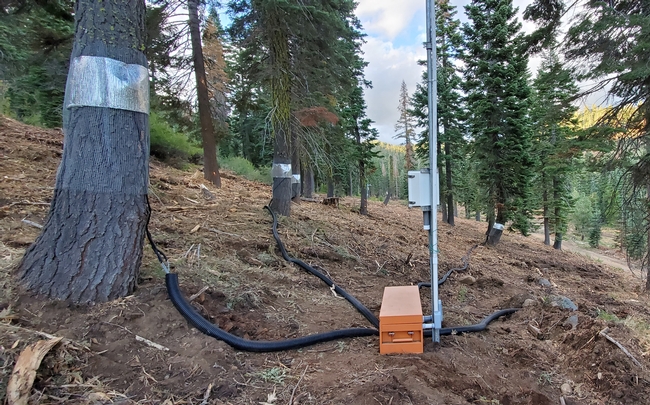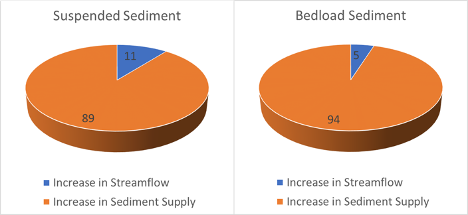New research clarifies impacts of timber harvest on sediment in watersheds
To effectively reduce these adverse effects of harvest, foresters first need to know the precise causes of sediment increases. Historically, researchers investigating the effects of timber harvest on the land have considered two primary drivers: hydrologic changes following timber harvest or fuel reduction that drive sediment transport, and increased sediment supply from ground disturbances and/or mass movements that result from those harvest or fuel reduction activities.
While these causes are tightly linked, little is understood about the relative role each plays in transporting sediment from the watersheds. In other words, which is dominant in increasing sediment delivery and transport: increased streamflow due to greater water availability that can sweep up and transport sediment, or a greater supply of sediment entering the waterway in the first place?
A new analytical approach developed by Safeeq Khan, UC Cooperative Extension specialist in water and watershed sciences at UC Merced, and collaborators now provides valuable insights into this issue, and ways to target effective mitigation strategies.
Published in the Journal of Hydrology last fall, the team's study analyzed long-term (1952-2017) streamflow and sediment data from two adjacent paired watersheds in the H. J. Andrews Experimental Forest in the western Cascades Range of Oregon. One of the watersheds was harvested and replanted in the 1960s, while the second was not disturbed and used as a control.
“The data is from Oregon, but highly relevant for our work in the Sierra Nevada,” said Khan, lead author of the study. “We have tried to quantify the effect of hydrologic changes and increased sediment supply from logging activities on total sediment yield.”
To isolate the relative contributions of streamflow changes and increased sediment supply on sediment transport, Khan and colleagues developed a statistical reconstruction technique to account for the hydrologic changes following harvest.
“This approach allows us to analyze and estimate background sediment production in the treated watershed during the post-treatment period as if the harvest had not occurred, which is remarkable,” said Khan.
The new approach demonstrated that sharp increases in sediment following harvests can be confidently attributed to ground disturbances associated with timber harvest or thinning operations to reduce fuel. Changes in sediment supply overwhelmingly dominate streamflow in terms of contributions to increased sediment in the watershed. Streamflow increases alone led to modest increases in sediment, less than 10%, with the watershed transporting about twice as much total sediment than it would have had the area been left unharvested. This effect diminishes more or less exponentially over time, especially with respect to suspended sediment, as bare areas revegetate, which reduces hillslope sediment supply, and as streamflow returns to pre-treatment levels.
“Once we know the background sediment production, we can easily attribute how much of the increase is due to what mechanisms” said Gordon Grant, a hydrologist with the U.S. Forest Service Pacific Northwest Research Station and co-author on the study.
“Determining that increased sediment in watersheds after harvests is primarily driven by ground disturbance is crucial in targeting mitigation efforts,” explained Khan. “Now, we know that strategies that limit ground disruption – like suspending logs while transporting instead of dragging them, avoiding heavy machinery when and where possible, and mastication and mulching – are likely to be highly effective in reducing sediment yields.”
These changes are most pronounced in the first few years following harvest, but the treated watershed did not return to pre-harvest levels of sediment for two decades, underscoring the long-term effects of harvest on a forest's hydrologic and geomorphic systems.
While clearcutting is no longer practiced on U.S. federal land, it is still the primary timber harvest method used across the globe. Additionally, many other types of forest disturbances such as wildfires, mass tree die-offs, and salvage logging create hydrogeomorphic conditions not too different from clearcutting.
"Our findings provide insights that can help land managers and foresters better target land management and restoration in the future,” said Khan. “We're hopeful that these results will lead to strategies that minimize the long-term impacts and legacies of intense land-use disturbances.”
The full study, titled “Disentangling effects of forest harvest on long-term hydrologic and sediment dynamics, western Cascades, Oregon" is available online in the Journal of Hydrology at https://www.sciencedirect.com/science/article/pii/S0022169419309941?via%3Dihub.




Posted by Tom Dinwoodie on August 16, 2020 at 8:12 PM